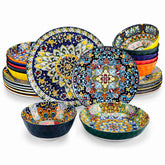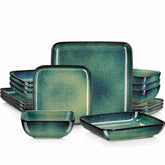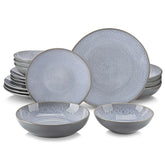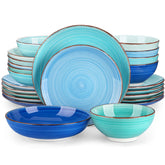10 Types of Bowls and Their Uses in Your Kitchen
Navigation
- Types of Bowls and Their Features
- Can Different Types of Bowls Be Used Interchangeably?
- Materials of Bowls: Pros and Cons
- Get the Right Bowls for Your Kitchen Needs
Explore the types of bowls that will be important to you and the people you cook and eat with, from unique features and uses to materials, to select the best ones for your kitchen.
Bowls are a kitchen essential and serve a variety of purposes-from prepping to dining. All different styles of bowls fulfill unique needs and make cooking and serving easier, faster, and more fun. Using the correct bowl can help elevate food's visual presentation, keep food at different temperatures, and even improve the total dining experience. Digging into the differences between bowls can help you, whether you are a home cook or a professional chef, to optimize your kitchen.
Types of Bowls and Their Features
Soup Bowls
Soup bowls are usually deep and have wide rims, or even without rims, which make them retain heat better and suited for foods that are liquid-based. These bowls are available in multiple materials, such as ceramic, porcelain, and glass. Soup bowls are used to serve different types of soups, such as broth-based, cream-based, and hearty stews. Most soup bowls have handles to make it easier to serve up a hot dish.
Salad Bowls
Salad bowls are relatively shallow, and their wider capacity allows you to toss and combine your ingredients with ease. Salad bowls are usually made of glass, wood, and ceramic. Salad bowls are designed to serve fresh vegetable salads as well as fruit salads and can also include grain ails, such as quinoa or couscous. Big salad bowls serve family-style, and small ones serve individuals.
Rice Bowls
Rice bowls have a round bottom for easy grasp and are small in size. These bowls are made of ceramic or porcelain and are mostly used in Asian households. A Rice Bowl is a type of bowl used for steamed rice but can also hold small portions of side dishes, such as pickled vegetables, tofu, or miso soup.
Noodle Bowls
Noodle bowls are deep, wide, and huge. They hold large servings of noodles, broth, and toppings. These are meant to keep heat so that food can remain hot for a longer duration of time. Filling and flavorful noodle bowls are great for a generous serving of ramen, pho, udon, pasta, or stir-fried noodles. In some cases, the noodle bowl has a wide rim to hold the chopsticks.
Mixing Bowls
Mixing bowls are those super big, deep containers that also come with non-slip bases! Some feature pour spouts and measurement markings, too. Mixing bowls are all the bowls you need to mix up batters or dough, or even salad ingredients or marinades. The stainless steel and glass options are preferred for durability and ease of cleaning.
Cereal Bowls
Cereal bowls are moderately deep and medium size. These bowls are able to accommodate foods with a lot of liquid. Cereal bowls are used for breakfast cereals (e.g., with milk/cream), oatmeal or porridge, yogurt with fruits, etc. Cereal bowls are ideal for single servings of pasta or same-serving grain dishes.
Baking Bowls
The baking bowls are heat resistant and have thick walls so that the heat is distributed evenly. From glass to ceramic and stoneware, these bowls come in all kinds of materials. Baking bowls are exclusively for baking and are used to make puddings, soughhés, and cakes. A few of those bowls come with lids to facilitate an easy oven-to-table transition.
Appetizer Bowls
Appetizer bowls are usually smaller than other types of bowls. These bowls are perfect for one-bite portions. Typically, appetizer bowls have a little more design appeal because they are often used to enrich the aesthetic splendor of a food presentation. These bowls are multifunctional. You can serve appetizers (dips, nuts, olives & sauces), and these bowls are also put into use when you have guests over and want to serve them food or side dishes.
Dessert Bowls
Dessert bowls come in different designs, sizes, and styles. Dessert bowls are usually made of glass or ceramic to give them a classy and elegant appearance. Dessert bowls are best for serving ice creams, fruit salads, pudding and mousse, and other desserts. Some dessert bowls have beautiful and stunning design details.
Storage Bowls
Storage Bowls are fitted with lids to create an airtight seal, which keeps your food fresher for a longer period. Storage bowls are made of glass, plastic, and stainless steel. Storage bowls contain leftovers, as well as meal prep and lunch on the go. Many of these storage bowls are also safe to use in the microwave, so reheating is easy.
Can Different Types of Bowls Be Used Interchangeably?
Yes, you can use different bowls interchangeably in a pinch, but using the right bowl for each job makes cooking and eating much better. For example, using a broad cereal bowl for a steaming soup risks spillage or scalding hands, while cramming a capacious salad serving into a narrow noodle bowl forfeits presentation. Similarly, material composition affects versatility - where fragile glass or durable ceramic accept alternately piping and chilled servings, heat-sensitive plastic risks damage or degradation from torrid temperatures. Functional form and durable design distinguish types meant for mixing, mingling, or merely holding morsels, meaning the aptly adapted option allows full appreciation of flavor, form, and filling.
Materials of Bowls: Pros and Cons
Ceramic (Stoneware and Porcelain)
Durability aside, ceramic bowls, especially stoneware and porcelain, also have a duo of practical and beautiful textures that have become increasingly sought-after. Stoneware is a durable ceramic that retains heat well and features a rugged, artisanal appearance that literally makes it perfect for soups, stews, and even pasta. It will be less likely to chip than porcelain and frequently be microwave and oven-safe. Stoneware can be thick, and if it is unglazed, it can become porous and absorb fluids. It is still strong but can break just like glass if you drop it, so you have to be careful how you use it.
Porcelain is an elegant, sturdy ceramic dinnerware that has a glossy finish, making it an ideal choice for special occasions. It is microwave, oven-safe, and non-porous, which means it does not absorb stains or odors. More fragile than stoneware, it will chip or break when dropped, so be cautious when cleaning. The elegance of its design means that this cookware is perfect for serving dishes in a beautifully arranged fashion.
Wooden Bowls
Bowls made from wood give a natural, rustic, and eco-friendly touch that works great for dry foods, such as salads or fruits. They're much lighter, last longer, and biodegradable. However, they should not be used on liquids, which can lead to warping or cracking. If well-cared, which means hand-washed and oiled once in a while, they can last a lifetime. However, they are a more traditional choice for the kitchen. The aesthetic and natural warmth they bring are timeless, but they will require more maintenance.
Glass Bowls
Glass bowls are so practical and effective that they can be beneficial for looking at the food easily. They are inert, so they are safe from acidic ingredients, and they are microwave- and oven-safe. On the other hand, they are prone to breaking when dropped and are not as good in terms of heat retention compared to ceramic. Nonetheless, their smarter appearance and practical purpose have made them a mainstay in most kitchens.

Stainless Steel Bowls
Stainless steel bowls are ideal for mixing, food prep, and storage, as they are strong, rust-resistant, and lightweight. Stainless steel bowls are attractive and permanent, but also a bit overpriced for the non-microwave and non-hot-holding way of keeping them. However, their durability and flexibility are what make them kitchen staples.
Plastic Bowls
Plastic bowls are one of the most cost-effective, lightweight options, and they also offer colors and designs for everyday convenience. It is not heat-resistant and will generally stain or absorb odors over time, but they are simple to use. However, in spite of these disadvantages, their multifunctional usages and costs keep them at the top of users' lists.
Bamboo Bowls
Stylish, lightweight bamboo bowls are biodegradable and safe, offering an eco-friendly alternative. Bamboo bowls are ideal for dry food but not for hot or liquid-based food. However, they demand hand washing since they are not dishwasher-safe. Even with these points of weakness, their organic character and eco-friendliness make them appealing for casual dinners.
Get the Right Bowls for Your Kitchen Needs
Want to cook and serve like a pro? Get the right bowls for your kitchen! Whether you love making salads or serving soups, good bowls make every meal better. Take a look at your cooking style and grab the bowls that fit your needs!












